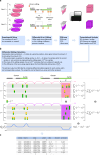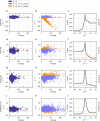LoDEI: a robust and sensitive tool to detect transcriptome-wide differential A-to-I editing in RNA-seq data
- PMID: 39443485
- PMCID: PMC11500352
- DOI: 10.1038/s41467-024-53298-y
LoDEI: a robust and sensitive tool to detect transcriptome-wide differential A-to-I editing in RNA-seq data
Abstract
RNA editing is a highly conserved process. Adenosine deaminase acting on RNA (ADAR) mediated deamination of adenosine (A-to-I editing) is associated with human disease and immune checkpoint control. Functional implications of A-to-I editing are currently of broad interest to academic and industrial research as underscored by the fast-growing number of clinical studies applying base editors as therapeutic tools. Analyzing the dynamics of A-to-I editing, in a biological or therapeutic context, requires the sensitive detection of differential A-to-I editing, a currently unmet need. We introduce the local differential editing index (LoDEI) to detect differential A-to-I editing in RNA-seq datasets using a sliding-window approach coupled with an empirical q value calculation that detects more A-to-I editing sites at the same false-discovery rate compared to existing methods. LoDEI is validated on known and novel datasets revealing that the oncogene MYCN increases and that a specific small non-coding RNA reduces A-to-I editing.
© 2024. The Author(s).
Conflict of interest statement
The authors declare no competing interests.
Figures






Similar articles
-
Biochemical and Transcriptome-Wide Identification of A-to-I RNA Editing Sites by ICE-Seq.Methods Enzymol. 2015;560:331-53. doi: 10.1016/bs.mie.2015.03.014. Epub 2015 Jul 9. Methods Enzymol. 2015. PMID: 26253977
-
Bioinformatic approaches for accurate assessment of A-to-I editing in complete transcriptomes.Methods Enzymol. 2025;710:241-265. doi: 10.1016/bs.mie.2024.11.020. Epub 2024 Nov 23. Methods Enzymol. 2025. PMID: 39870448 Review.
-
Changes in ADAR RNA editing patterns in CMV and ZIKV congenital infections.BMC Genomics. 2023 Nov 15;24(1):685. doi: 10.1186/s12864-023-09778-4. BMC Genomics. 2023. PMID: 37968596 Free PMC article.
-
Noncoding regions of C. elegans mRNA undergo selective adenosine to inosine deamination and contain a small number of editing sites per transcript.RNA Biol. 2015;12(2):162-74. doi: 10.1080/15476286.2015.1017220. RNA Biol. 2015. PMID: 25826568 Free PMC article.
-
Computational approaches for detection and quantification of A-to-I RNA-editing.Methods. 2019 Mar 1;156:25-31. doi: 10.1016/j.ymeth.2018.11.011. Epub 2018 Nov 20. Methods. 2019. PMID: 30465820 Review.
Cited by
-
ADARs: pleiotropy in function, versatility in application.Nucleic Acids Res. 2025 Jul 8;53(13):gkaf672. doi: 10.1093/nar/gkaf672. Nucleic Acids Res. 2025. PMID: 40671518 Free PMC article. Review.
References
Publication types
MeSH terms
Substances
Associated data
- Actions
- Actions
- Actions
- Actions
- Actions
Grants and funding
LinkOut - more resources
Full Text Sources
Molecular Biology Databases
Research Materials

